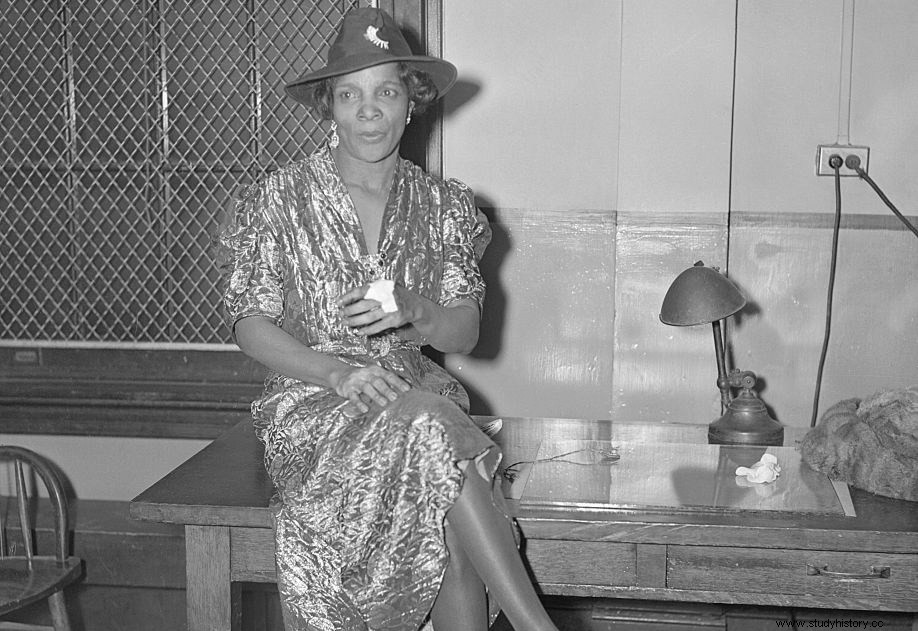Gang leader Stephanie St. Clair (1887 – 1969) ran criminal enterprises in Harlem, New York, managing to remain independent of the American mafia. She will be nicknamed “Queenie” or “Madame Saint-Clair”.
[Warning:rape, violence, racist crimes]
New York
 Stéphanie St. Clair was born in December 1887, in Fort-de-France in Martinique or Le Moule in Guadeloupe, as she herself will indicate later. Little is known of his youth; even its date is questionable, possibly a few years later. But after growing up in the French West Indies, Stéphanie decides to start a new life elsewhere.
Stéphanie St. Clair was born in December 1887, in Fort-de-France in Martinique or Le Moule in Guadeloupe, as she herself will indicate later. Little is known of his youth; even its date is questionable, possibly a few years later. But after growing up in the French West Indies, Stéphanie decides to start a new life elsewhere.
Francophone, she settled, at first, in France; other sources credit him with a few years of work in Canada. But as a woman, black, and alone, Stephanie does not manage to obtain a satisfactory situation and decides to try her luck elsewhere. In 1911, in Marseilles, she embarked on the boat The Guiana, and makes landfall in New York in July. After using his months of travel to learn English.
In Harlem, Stephanie meets a little crook named Duke, with whom she begins an affair. But when he tries to prostitute her, she sends him to the hospital with a bloody eye and rushes off on a bus to Minnesota. The following night, the bus is stopped by the Ku Klux Klan. Several black passengers are brutally murdered; Stéphanie, she undergoes new repeated rapes. Upon her return to New York, she learns that Duke was shot in a gang shootout.
Racket Numbers
Determined to get a job, Stéphanie St. Clair embarked on the gambling business and in particular a popular clandestine lottery at the time (called "numbers racket" [English]). At the time, in the midst of racial segregation in the United States, many banks refused black customers, who could not invest legally. Some, like Stephanie, then invest through gambling and Harlem's underground economy.
One of the very few women involved in the numbers racket , Stéphanie quickly made a name for herself and, above all, a very substantial income. She hires lawyers, bodyguards, bankers, bet takers. And does not hesitate to use the strong method to fight against those who oppose her, with the help of her trusted man Ellsworth "Bumpy" Johnson. The white mafia nicknamed her “Queenie”; in Harlem, they prefer to call her “Madame Saint-Clair”.
The Harlem Community
Stéphanie St. Clair buys an apartment on Edgecombe Avenue . She rubs shoulders, in particular, with the Pan-African activist W.E.B. Du Bois, anti-racist poet Countee Cullen, and other Harlem Renaissance actors. Despite the illegality of her activities and the violence that her methods can take on, Stéphanie creates many jobs within the black community of Harlem. More than one of its figures and despite her foreign origins, she became, during her lifetime, one of its representatives.
Beyond the jobs created and the money donated, Stéphanie defends in her own way the rights of the black community of Harlem. In local newspapers, it publishes advertisements to inform in particular about the right to vote and to denounce police violence. Faced with the lack of reaction from the authorities, she published direct accusations of corruption against police officers in the Harlem newspapers. With good reason:she noted in a notebook the bribes paid, and the names of those who participate in the numbers racket .
A dozen police officers are removed from their posts, but Stephanie will serve an eight-month prison sentence for corruption of police officers and magistrates.
Conflicts with the American Mafia
In 1933, the end of prohibition in the United States marked a sharp decline in the profits of the American mafia, which then decided to take an interest in the illegal betting market in Harlem. Gang leader Dutch Schultz, in particular, forces numbers racketeers actors through threats, beatings and even murders. to pay for his protection. Many submit to it. Stephanie refuses. She responds to death threats and violence by smashing the windows of Dutch Schultz's partners, then selling him to the police. "I'm not afraid of anyone" , she said in the press.
After this conflict, Stephanie walks away from business to avoid trouble with the police, and entrusts her business to "Bumpy" Johnson. Faced with the aggressive arrival of the Italian-American mobster Lucky Luciano in the field of illegal betting in Harlem, "Bumpy" will end up negotiating a truce and agreeing to pay a tax.
In 1935, Dutch Schultz was assassinated on the orders of the five families of the American mafia. Stéphanie is not involved in this murder, but she grants herself a little revenge by sending him, on his deathbed, a pithy telegram:"As ye sow, so shall ye reap. » (We reap what we sow).
End of life
Retired from business, Stéphanie St. Clair meets Sufi activist Abdul Hamid, nicknamed “Black Hitler” for his overt anti-Semitism, whom she marries. Their marriage quickly turns sour, probably due to Sufi Abdul Hamid's infidelity. In 1938, he was shot on his way to meet his lawyer; Stephanie maintains her innocence, saying that if she had wanted to kill him, he would be dead, but she is convicted and spends several years in prison.
Released from prison, Stéphanie continues to write in newspapers to denounce the discrimination suffered by the black community, including police violence and abuse of power. She died in 1969, a year after “Bumpy” Johnson.
